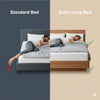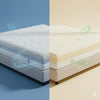How Much Space Do You Really Need for a Super King Size Bed?
- by Giorgi Gogidze

When it comes to bedroom furniture, few decisions are as important as choosing the right bed size. The allure of a super king size bed is undeniable – sprawling comfort, luxurious sleeping space, and the ultimate in bedroom indulgence. However, before you commit to this impressive piece of furniture, it's crucial to understand exactly how much space you'll need to accommodate it properly.
A super king size bed represents the pinnacle of sleeping luxury, but it also demands careful consideration of your room dimensions, layout, and lifestyle needs. Unlike a standard king size bed, which already requires significant space planning, a super king bed takes bedroom real estate to an entirely new level. Understanding the spatial requirements isn't just about fitting the bed into your room – it's about creating a functional, comfortable, and aesthetically pleasing bedroom environment.
[toc]
The question of space goes beyond simple measurements. It encompasses walkway clearances, furniture placement, door swing considerations, and the overall flow of your bedroom. Whether you're renovating your master bedroom, moving to a new home, or simply dreaming of upgrading your sleep setup, understanding these spatial requirements will help you make an informed decision that you'll be happy with for years to come.
Super King Size Bed Dimensions and Basic Space Requirements
A super king size bed typically measures 180cm x 200cm (6ft x 6ft 6in), making it significantly larger than a standard king size bed, which measures 150cm x 200cm (5ft x 6ft 6in). This additional 30cm (12 inches) of width might not seem dramatic on paper, but it translates to a substantial difference in both sleeping comfort and room space requirements.
The super king bed frame adds additional dimensions to consider. Depending on the style and design, frames can add anywhere from 5cm to 15cm to each side of the bed's footprint. A substantial wooden super king bed frame with thick posts or an upholstered frame with wide borders will require even more space than a minimalist metal frame.
To properly accommodate a super king size bed, interior designers typically recommend a minimum room size of 3.6m x 4.2m (12ft x 14ft). This allows for the bed itself plus essential walkway space around the perimeter. However, this is truly the minimum – for a comfortable, functional bedroom, you'll want considerably more space.
The ideal room size for a super king bed is approximately 4.2m x 4.8m (14ft x 16ft) or larger. This provides adequate space for the bed, comfortable movement around it, and room for additional bedroom furniture like nightstands, dressers, and seating areas.
King Size Bed vs Super King Size Bed: Space Comparison
Understanding the difference between a king size bed and a super king size bed is crucial for space planning. A standard king size bed requires a minimum room size of approximately 3.0m x 3.6m (10ft x 12ft), while a super king bed needs at least 3.6m x 4.2m (12ft x 14ft). This represents a significant increase in required floor space.
The additional width of a super king bed compared to a king size bed might seem modest, but it has profound implications for room layout. That extra 30cm affects not just the bed's footprint but also the placement of other furniture pieces. Nightstands, for instance, may need to be repositioned or downsized to maintain proper walkway clearances.
A king size bed frame typically works well in rooms where space is somewhat limited but you still want generous sleeping space. The super king bed frame, conversely, is best suited to genuinely spacious master bedrooms where the bed can serve as a stunning focal point without overwhelming the room's proportions.
The choice between these sizes often comes down to balancing luxury with practicality. While a super king bed offers unparalleled sleeping comfort, a king size bed might be the more sensible choice for rooms where space is at a premium or where you need to accommodate substantial additional furniture.
Essential Clearance Measurements Around a Super King Bed
Proper clearance around your super king size bed is essential for both functionality and aesthetics. The standard recommendation is to maintain at least 60cm (24 inches) of clearance on all sides of the bed. This provides adequate space for making the bed, walking around it comfortably, and accessing storage or other furniture.
On the sides where you'll be getting in and out of bed, 90cm (36 inches) of clearance is preferable. This extra space makes it easier to move around the bed, especially when carrying items or when two people are using the space simultaneously. If you're placing nightstands beside the bed, factor in their depth as well – a typical nightstand is 40-50cm deep, so you'll need at least 130-140cm from the bed edge to the wall.
At the foot of the bed, 90cm (36 inches) of clearance is also recommended. This space allows for easy bed-making and provides room for a bench, ottoman, or other bedroom furniture. If your room layout requires placing a dresser or other furniture at the foot of the bed, ensure there's still adequate walkway space between the bed and the furniture piece.
Door clearances are another crucial consideration. Bedroom doors typically need at least 90cm of clearance to open fully without hitting the bed or super king bed frame. If your door opens into the bedroom, measure carefully to ensure the door swing doesn't interfere with the bed placement.
Super King Bed Frame Styles and Their Space Impact
The style of super king bed frame you choose can significantly impact your room's spatial requirements and overall feel. A low-profile platform super king bed frame creates a more open, airy feeling in the room and can make the space appear larger than it actually is. These frames typically sit closer to the ground and often have a more minimalist aesthetic.
Traditional four-poster super king bed frames make a dramatic statement but require substantial ceiling height and room proportions to avoid overwhelming the space. These frames need rooms with ceilings of at least 2.7m (9 feet) high, and ideally 3.0m (10 feet) or higher, to maintain proper visual proportions.
Upholstered super king bed frames with tall headboards can serve as stunning focal points but require careful consideration of wall space and room proportions. A large, dramatic headboard might overwhelm a smaller room, while it could be the perfect statement piece in a spacious master suite.
Storage bed frames offer excellent functionality but may require additional clearance for drawer operation or ottoman-style lifting mechanisms. If you're considering a storage super king bed frame, ensure you have adequate space for drawers to open fully – typically an additional 60cm beyond the standard clearance requirements.
Room Layout Strategies for Super King Size Beds
Successful room layout with a super king size bed requires strategic planning and creative thinking. The bed's substantial size means it will likely dominate the room, so embrace this reality and make it the intentional focal point of your design.
Centering the bed on the longest wall is often the most effective approach, as this typically provides the most balanced clearances on all sides. However, if your room is unusually shaped or has multiple doorways, you might need to experiment with different positioning to find the optimal layout.
Consider the room's architectural features when planning placement. Windows, built-in features, and sloped ceilings can all impact where you can realistically position a super king bed. Ensure the bed placement doesn't block natural light sources or interfere with window treatments.
The placement of other furniture becomes more challenging with a super king size bed. You may need to choose smaller-scale pieces or reduce the total number of furniture items to maintain proper proportions and functionality. Consider wall-mounted nightstands, floating shelves, or built-in storage solutions to maximize floor space.
Practical Considerations Beyond Basic Measurements
Moving and positioning a super king size bed involves practical challenges that go beyond room measurements. Consider how you'll get the bed and mattress into your bedroom – will it fit through doorways, up staircases, and around corners? Some super king mattresses can be quite heavy and unwieldy, potentially requiring professional delivery and setup.
Bedding and linens for a super king bed are typically more expensive and may have limited availability compared to standard king size bed options. Factor these ongoing costs into your decision-making process.
Cleaning and maintenance also become more involved with a super king size bed. The larger surface area means more space to vacuum underneath, and the increased bed size may require repositioning furniture more frequently for thorough cleaning.
Making the Most of Your Super King Bed Space
If you've determined that your room can accommodate a super king size bed, there are several strategies to maximize both the luxury and functionality of your space. Choose a super king bed frame style that complements your room's proportions rather than fighting against them.
Consider built-in or custom furniture solutions that work harmoniously with your super king bed. Built-in nightstands, window seats, or storage solutions can provide functionality without adding visual clutter or consuming precious floor space.
Lighting becomes particularly important in rooms with super king beds. Table lamps on traditional nightstands might not provide adequate reading light across the bed's width. Consider pendant lights, wall-mounted reading lights, or adjustable task lighting to ensure both sides of the bed are well-lit.
Alternative Solutions for Smaller Spaces
If your room measurements fall short of the ideal super king bed requirements, consider these alternatives. A standard king size bed might provide the luxury sleeping experience you're seeking while better fitting your space constraints.
Alternatively, you might consider redesigning your bedroom layout or even renovating to create more space. Sometimes removing a wall, converting an adjacent room, or reconfiguring the existing space can create the room needed for your dream super king bed.
Another option is to prioritize the super king bed and carefully select compact furniture pieces for the rest of the room. Floating nightstands, wall-mounted storage, and multi-functional furniture can help you accommodate the bed while maintaining room functionality.
The Investment Decision
Choosing a super king size bed is a significant investment in both money and space. The bed itself is typically more expensive than smaller sizes, and the spatial requirements may limit your furniture options or necessitate room modifications.
However, for those who have the space and budget, a super king bed can transform your bedroom into a true sanctuary. The extra sleeping space, luxurious feel, and impressive presence can significantly enhance your daily life and sleep quality.
Consider your long-term plans as well. If you're planning to move in the near future, will your next home accommodate a super king bed? The substantial size means it's not suitable for every bedroom, potentially limiting your housing options.
Conclusion
A super king size bed requires careful space planning, but for those with adequate room, it offers unparalleled sleeping luxury. The minimum room size of 3.6m x 4.2m should be considered just that – a minimum. For optimal comfort and functionality, aim for a room of at least 4.2m x 4.8m.
Remember that successful integration of a super king bed involves more than just fitting it into your room. Consider clearances, furniture placement, lighting, and the overall flow of your bedroom space. With proper planning, a super king size bed can become the centerpiece of a truly luxurious and functional bedroom retreat.
Whether you choose a king size bed or make the leap to a super king bed, the key is understanding your space constraints and designing around them thoughtfully. The result will be a bedroom that serves both your practical needs and your dreams of ultimate sleeping comfort.




